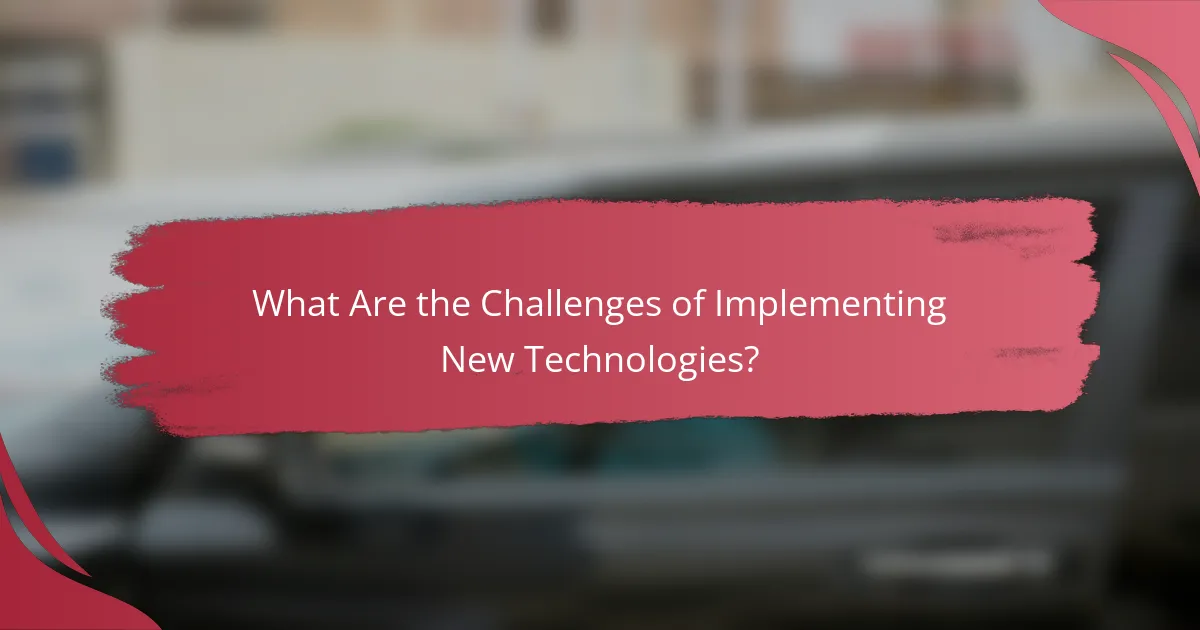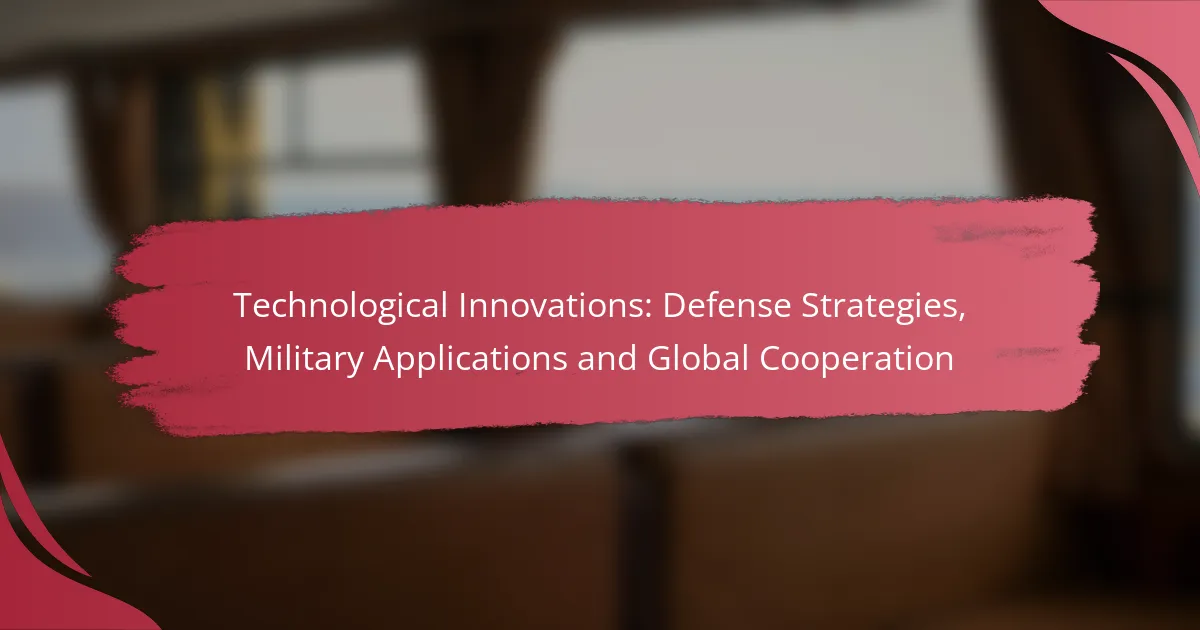Technological innovations are transforming defense strategies through advancements in artificial intelligence, cybersecurity, and autonomous systems. These developments not only enhance military capabilities and operational efficiency but also foster global cooperation, allowing nations to share resources and knowledge. As countries collaborate on defense technologies, they improve combat readiness and contribute to regional stability.

What Are the Key Technological Innovations in Defense?
Key technological innovations in defense include advancements in artificial intelligence, cybersecurity, autonomous systems, surveillance technologies, and quantum computing. These innovations enhance military capabilities, improve operational efficiency, and foster international cooperation in defense strategies.
Artificial Intelligence in Military Operations
Artificial intelligence (AI) is transforming military operations by enabling data analysis, decision-making, and automation. AI systems can process vast amounts of information quickly, providing commanders with actionable insights in real-time.
For example, AI-driven predictive analytics can enhance logistics by forecasting supply needs, while machine learning algorithms improve threat detection in surveillance systems. However, integrating AI requires careful consideration of ethical implications and potential biases in data.
Cybersecurity Enhancements
Cybersecurity enhancements are crucial for protecting military networks and sensitive information from cyber threats. Modern defense strategies incorporate advanced encryption, intrusion detection systems, and continuous monitoring to safeguard data integrity.
Investing in cybersecurity training for personnel is essential, as human error remains a significant vulnerability. Regularly updating software and conducting penetration testing can help identify and mitigate potential weaknesses in defense systems.
Autonomous Weapon Systems
Autonomous weapon systems are designed to operate without direct human intervention, utilizing AI and machine learning to identify and engage targets. These systems can enhance operational efficiency and reduce risks to personnel in high-stakes environments.
However, the deployment of autonomous weapons raises ethical concerns regarding accountability and decision-making in combat scenarios. Military organizations must establish clear guidelines and regulations to govern their use and ensure compliance with international law.
Advanced Surveillance Technologies
Advanced surveillance technologies, such as drones and satellite imaging, provide military forces with enhanced situational awareness. These tools enable real-time monitoring of vast areas, improving intelligence gathering and threat assessment.
Incorporating technologies like facial recognition and motion detection can further enhance surveillance capabilities. However, privacy concerns and the potential for misuse necessitate strict regulations and oversight to balance security needs with civil liberties.
Quantum Computing Applications
Quantum computing holds the potential to revolutionize defense strategies by solving complex problems at unprecedented speeds. This technology can enhance cryptography, optimize logistics, and improve simulations for military operations.
While still in its early stages, quantum computing could significantly impact secure communications and data processing. Defense organizations should stay informed about advancements in this field to leverage its capabilities effectively and maintain a strategic edge.

How Are These Innovations Applied in Military Strategies?
Technological innovations are integral to modern military strategies, enhancing operational efficiency and effectiveness. These advancements facilitate better decision-making, streamline logistics, and enable real-time data analysis, ultimately improving combat readiness and strategic outcomes.
Enhanced Decision-Making Processes
Enhanced decision-making processes in military strategies leverage advanced technologies such as artificial intelligence and machine learning. These tools analyze vast amounts of data quickly, providing commanders with actionable insights that can influence tactical choices on the battlefield.
For example, AI-driven simulations can predict enemy movements and assess potential outcomes of various strategies, allowing military leaders to make informed decisions in high-pressure situations. This capability reduces the time needed for analysis, often condensing hours of data review into mere minutes.
Improved Logistics and Supply Chain Management
Improved logistics and supply chain management are critical for maintaining operational readiness in military operations. Technologies like automated inventory systems and blockchain enhance transparency and efficiency in the supply chain, ensuring that troops receive necessary supplies promptly.
Utilizing predictive analytics, military logistics can anticipate supply needs based on troop movements and operational demands. This proactive approach minimizes delays and reduces waste, ultimately saving costs and resources, which is crucial in budget-sensitive environments.
Real-Time Data Analysis for Combat Situations
Real-time data analysis is vital for effective combat situations, allowing military forces to respond swiftly to changing conditions on the ground. Technologies such as drones and satellite imagery provide continuous surveillance, feeding data back to command centers for immediate analysis.
In practice, this means that commanders can adjust strategies based on live intelligence, enhancing situational awareness and improving response times. For instance, if enemy positions change, real-time data allows for rapid reassessment of tactics, ensuring that military operations remain agile and effective.

What Role Does Global Cooperation Play in Defense Innovations?
Global cooperation is essential for advancing defense innovations, as it enables countries to share resources, knowledge, and technologies. Collaborative efforts enhance military capabilities while promoting peace and stability across regions.
Joint Military Exercises and Training Programs
Joint military exercises and training programs allow nations to practice interoperability and refine their tactics in real-world scenarios. These collaborations often involve multiple countries working together to simulate combat situations, which helps identify strengths and weaknesses in their respective strategies.
For instance, NATO conducts various exercises annually, such as the Trident Juncture, which includes forces from member states and partner nations. These exercises not only improve readiness but also foster relationships among military personnel.
International Defense Agreements
International defense agreements facilitate cooperation between nations, outlining mutual support in times of conflict or crisis. These agreements can take the form of treaties, memorandums of understanding, or formal alliances, providing a framework for joint operations and resource sharing.
Examples include the North Atlantic Treaty Organization (NATO) and the Five Eyes alliance, which enhance collective security and intelligence sharing among member countries. Such agreements often stipulate defense spending targets and collaborative projects to strengthen military capabilities.
Collaborative Research Initiatives
Collaborative research initiatives focus on developing advanced technologies and solutions for defense applications. Countries often pool their scientific expertise and funding to tackle complex challenges, such as cybersecurity, artificial intelligence, and unmanned systems.
Programs like the European Defence Fund (EDF) support joint research projects among EU member states, aiming to foster innovation and reduce duplication of efforts. By working together, nations can accelerate the development of cutting-edge technologies while sharing the associated costs and risks.

What Are the Challenges of Implementing New Technologies?
Implementing new technologies in defense strategies faces several challenges, including budget constraints, ethical dilemmas, and interoperability issues. These factors can significantly impact the effectiveness and acceptance of technological innovations in military applications.
Budget Constraints and Funding Issues
Budget constraints are a primary challenge in adopting new technologies for defense. Military budgets often prioritize existing programs, leaving limited funds for innovative projects. As a result, defense agencies must balance the need for modernization with fiscal responsibility.
Funding issues can also arise from the lengthy procurement processes and the need for extensive testing and evaluation. Delays in funding can stall the development of crucial technologies, making it essential for military planners to advocate for flexible budget allocations that accommodate innovation.
Ethical Considerations in Autonomous Warfare
Ethical considerations are critical when integrating autonomous systems into military operations. The use of drones and AI-driven weaponry raises questions about accountability and the potential for unintended harm. Military leaders must navigate these ethical dilemmas while ensuring compliance with international humanitarian laws.
Establishing clear guidelines for the use of autonomous systems can help address these concerns. Engaging with ethicists, legal experts, and the public can foster a more comprehensive understanding of the implications of such technologies in warfare.
Interoperability Between Different Military Systems
Interoperability is a significant challenge when implementing new technologies across various military systems. Different branches of the armed forces often use incompatible systems, which can hinder effective communication and coordination during joint operations. Ensuring that new technologies can seamlessly integrate with existing platforms is crucial for operational success.
To improve interoperability, defense agencies should adopt standardized protocols and invest in systems that prioritize compatibility. Regular joint exercises can also help identify and resolve interoperability issues before they affect real-world missions.

How Do Countries Compare in Defense Technological Advancements?
Countries vary significantly in their defense technological advancements, influenced by factors such as investment levels, research capabilities, and strategic priorities. The United States and China lead in military technology, while the European Union focuses on collaborative defense initiatives, and India is rapidly developing emerging defense technologies.
United States vs. China in Military Tech
The United States and China are at the forefront of military technology, each with distinct strengths. The U.S. invests heavily in advanced systems like stealth aircraft, drones, and cyber capabilities, often spending hundreds of billions annually. In contrast, China has made significant strides in areas such as missile technology, artificial intelligence, and naval power, with a focus on modernization and self-sufficiency.
Key differences include the U.S. emphasis on maintaining global military presence and alliances, while China prioritizes regional dominance and rapid technological advancement. Both nations are engaged in a competitive race, with implications for global security dynamics.
European Union Defense Collaboration
The European Union is enhancing its defense capabilities through collaborative efforts among member states. Initiatives like the Permanent Structured Cooperation (PESCO) and the European Defence Fund aim to pool resources for joint military projects, fostering innovation and interoperability.
By sharing research and development costs, EU countries can develop advanced technologies collectively, such as drones and cybersecurity measures. This collaboration is essential for addressing common security threats and reducing reliance on external powers.
Emerging Defense Technologies in India
India is rapidly advancing its defense technology sector, focusing on indigenous development and innovation. The government has initiated programs like ‘Make in India’ to boost local manufacturing of defense equipment, including drones, missiles, and naval systems.
India’s defense strategy emphasizes self-reliance and modernization, with investments in artificial intelligence and cybersecurity becoming increasingly important. Collaborations with countries like the U.S. and Israel further enhance India’s technological capabilities, positioning it as a significant player in the global defense landscape.



